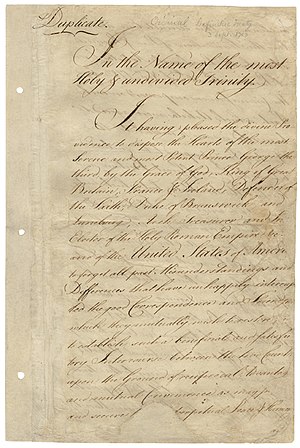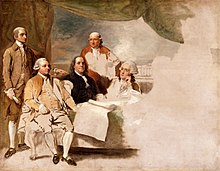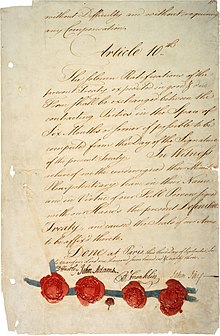| The Definitive Treaty of Peace Between the Kingdom of Great Britain and the United States of America | |
|---|---|
 The first page of the Treaty of Paris, signed on September 3, 1783 | |
| Drafted | November 30, 1782 |
| Signed | September 3, 1783 |
| Location | Paris, Kingdom of France |
| Effective | May 12, 1784 |
| Condition | Ratification by the Kingdom of Great Britain and the United States |
| Signatories | |
| Parties | |
| Depositary | United States government[1] |
| Language | English |
| Full text | |
The Treaty of Paris, signed in Paris by representatives of King George III of Great Britain and representatives of the United States on September 3, 1783, officially ended the American Revolutionary War and recognized the Thirteen Colonies, which had been part of colonial British America, to be free, sovereign and independent states.
The treaty set the boundaries between British North America, later called Canada, and the United States, on lines the British labeled as "exceedingly generous",[2] although exact boundary definitions in the far-northwest and to the south continued to be subject to some controversy. Details included fishing rights and restoration of property and prisoners of war.
This treaty and the separate peace treaties between Great Britain and the nations that supported the American cause, including France and Spain, are known collectively as the Peace of Paris.[3][4] Only Article 1 of the treaty, which acknowledges the United States' existence as free, sovereign, and independent states, remains in force.[5]



Peace negotiations began in Paris in April 1782, following the victory of George Washington and the Continental Army in the American Revolutionary War. The negotiations continued through the summer of 1782. Representing the United States were Benjamin Franklin, John Jay, Henry Laurens, and John Adams. Representing the Kingdom of Great Britain and King George III were David Hartley and Richard Oswald.
The treaty was drafted on November 30, 1782,[a] and signed at the Hôtel d'York at present-day 56 Rue Jacob in Paris on September 3, 1783, by Adams, Franklin, Jay, and Hartley.[6]
In September 1782, French Foreign Minister Vergennes proposed a solution to deadlocked negotiations between the United States and the British, which was rejected by the United States. France was exhausted by the war, and all parties sought peace, except for the Kingdom of Spain, which insisted on continuing the Revolutionary War until it could capture Gibraltar from the British. Vergennes developed treaty terms under which Spain would forego holding Gibraltar and the United States would be granted independence, but it would be confined to the area east of the Appalachian Mountains. Britain would keep the area north of the Ohio River, which was part of the Province of Quebec. In the area south of that would be an independent Indian barrier state, under Spanish control.[7]
The American delegation perceived that they could obtain a better treaty in negotiating directly with the British in London. John Jay promptly told the British that he was willing to negotiate directly with them and to bypass France and Spain, and British Prime Minister Lord Shelburne agreed. In charge of the British negotiations, some of which took place in his study at Lansdowne House, now a bar in the Lansdowne Club, Shelburne now saw a chance to split the United States from France and to establish the new nation as a valuable economic partner.[8] The terms were that the United States would gain all of the area east of the Mississippi River, north of present-day Florida, and south of present-day Canada. The northern boundary would be almost the same as it is today.[9]
The United States would gain fishing rights off Nova Scotia's coasts and agreed to allow British merchants and Loyalists to try to recover their property. The treaty was highly favorable for the United States and deliberately so from the British point of view. Shelburne foresaw highly profitable two-way trade between Britain and the rapidly-growing United States, which came to pass.[10]
Great Britain also signed separate agreements with France and Spain, and provisionally with the Netherlands.[11] In the treaty with Spain, the territories of East and West Florida were ceded to Spain without a clear northern boundary, which resulted in a territorial dispute resolved by the Treaty of Madrid in 1795. Spain also received the island of Menorca, but the Bahama Islands, Grenada, and Montserrat, which had been captured by the French and Spanish, were returned to Britain. The treaty with France was mostly about exchanges of captured territory. France's only net gains were the island of Tobago, and Senegal in Africa, but it also reinforced earlier treaties, guaranteeing fishing rights off Newfoundland. Dutch possessions in the East Indies, captured in 1781, were returned by Britain to the Netherlands in exchange for trading privileges in the Dutch East Indies by a treaty, which was not finalized until 1784.[12]
The Congress of the Confederation, operating as the legislative body of the newly established United States, ratified the Treaty of Paris on January 14, 1784, in Annapolis, Maryland, in the Old Senate Chamber of the Maryland State House.[13] Copies were sent back to Europe for ratification by the other parties involved, the first reaching France in March 1784. British ratification occurred on April 9, 1784, and the ratified versions were exchanged in Paris on May 12, 1784.[14]


The treaty and the separate peace treaties between Great Britain and the three colonial powers that supported the American cause, France, Spain, and the Dutch Republic, are known collectively as the Peace of Paris.[3][4] Only Article 1 of the treaty, which acknowledges the United States' existence as free sovereign and independent states, remains in force.[5] The U.S. borders changed in later years, which is a major reason specific articles of the treaty were superseded.[citation needed]
Preamble. Declares the treaty to be "in the Name of the Most Holy and Undivided Trinity" followed by a reference to the Divine providence[15] states the bona fides of the signatories, and declares the intention of both parties to "forget all past misunderstandings and differences" and "secure to both perpetual peace and harmony."
Eschatocol. "Done at Paris, this third day of September in the year of our Lord, one thousand seven hundred and eighty-three."
Historians have often commented that the treaty was very generous to the United States in terms of greatly enlarged boundaries. Historians such as Alvord, Harlow, and Ritcheson have emphasized that British generosity was based on a statesmanlike vision of close economic ties between Britain and the United States. The concession of the vast trans-Appalachian region was designed to facilitate the growth of the American population and to create lucrative markets for British merchants without any military or administrative costs to Britain.[8] The point was that the United States would become a major trading partner. As French Foreign Minister Vergennes later put it, "The English buy peace rather than make it."[2] Vermont was included within the boundaries because the state of New York insisted that Vermont was a part of New York although Vermont was then under a government that considered Vermont not to be a part of the United States.[17]
Privileges that the Americans had received from Britain automatically when they had colonial status, including protection from pirates in the Mediterranean Sea under which the First Barbary War and the Second Barbary War had been fought, were lost. Individual states ignored federal recommendations, under Article 5, to restore confiscated Loyalist property and Article 6, which provided for confiscating Loyalist property for "unpaid debts". The Commonwealth of Virginia defied Article 4 and maintained laws against payment of debts to British creditors. Several Loyalists attempted to file for a return for their property in the U.S. legal system after the American Revolutionary War, but most were unsuccessful.[18]
The actual geography of North America turned out not to match the details used in the treaty. The treaty specified a southern boundary for the United States, but the separate Anglo-Spanish agreement did not specify a northern boundary for Florida. The Spanish government assumed that the boundary was the same as in the 1763 agreement by which it had first given its territory in Florida to Great Britain. While the West Florida Controversy continued, Spain used its new control of Florida to block American access to the Mississippi, in defiance of Article 8.[19] To the north, the treaty stated that the boundary of the United States extended from the "most northwesternmost point" of the Lake of the Woods in present-day Minnesota, Manitoba, and Ontario, directly westward until it reached the Mississippi River. However, the Mississippi does not extend that far northward, and the line going west from the Lake of the Woods never intersects the river. Additionally, the Treaty of Paris did not explain how the new border would function in terms of controlling the movement of people and trade between British North America and the United States. The American diplomats' expectation of negotiating a commercial treaty with Great Britain to resolve some of the unfinished business of the Treaty of Paris failed to materialize in 1784. Despite government agreements for British evacuation of northern forts, Britain continued to occupy the forts. Meanwhile, the British were dissatisfied with the American harassment of loyalists.[20][21] The United States would thus wait until 1794 to negotiate its first commercial agreement with the British Empire, the Jay Treaty.[22]
Great Britain violated the treaty stipulation that it would relinquish control of forts in United States territory "with all convenient speed". British troops remained stationed at six forts in the Great Lakes region and at two at the north end of Lake Champlain. The British also built an additional fort in present-day Ohio in 1794, during the Northwest Indian War. They justified their treaty violations during the unstable and extremely tense time that existed in the area following the Revolutionary War, and in the failure of the newly established Federal government of the United States to fulfill commitments made to compensate loyalists for British losses, forcing the British to liquidate various assets in the region.[23] All of the posts were relinquished peacefully through diplomatic means as a result of the Jay Treaty:
| Name | Present-day location |
|---|---|
| Fort au Fer | Lake Champlain – Champlain, New York |
| Fort Dutchman's Point | Lake Champlain – North Hero, Vermont |
| Fort Lernoult (including Fort Detroit) | Detroit River – Detroit, Michigan |
| Fort Mackinac | Straits of Mackinac – Mackinac Island, Michigan |
| Fort Miami | Maumee River – Maumee, Ohio |
| Fort Niagara | Niagara River – Youngstown, New York |
| Fort Ontario | Lake Ontario – Oswego, New York |
| Fort Oswegatchie | Saint Lawrence River – Ogdensburg, New York |
a summary of his long book
United States articles | |||||||||||||||||||||||||||||||||||||||
|---|---|---|---|---|---|---|---|---|---|---|---|---|---|---|---|---|---|---|---|---|---|---|---|---|---|---|---|---|---|---|---|---|---|---|---|---|---|---|---|
| History |
| ||||||||||||||||||||||||||||||||||||||
| Geography | |||||||||||||||||||||||||||||||||||||||
| Politics |
| ||||||||||||||||||||||||||||||||||||||
| Economy |
| ||||||||||||||||||||||||||||||||||||||
| Society |
| ||||||||||||||||||||||||||||||||||||||
| Founding of the United States |
|
|---|---|
| Inventions, other events |
|
| Writings |
|
| Legacy |
|
| Related | |
| Family |
|
| |
| Founding of the United States |
|
| Elections | |
| Presidency |
|
| Other writings | |
| Life and homes | |
| Legacy |
|
| Popular culture |
|
| Related | |
| Adams family |
|
| |
| Founding of the United States |
|
| Other events | |
| Other writings | |
| Homes | |
| Namesakes | |
| Family | |
| Related | |